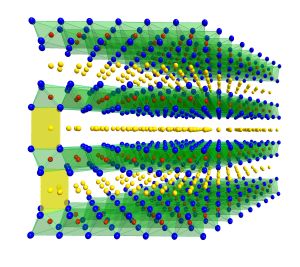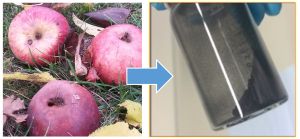A carbon-based active material produced from apple leftovers and a material of layered oxides might help reduce the costs of future energy storage systems. Both were found to have excellent electrochemical properties and stand for the environmentally compatible and sustainable use of resources. Now, these materials are presented by researchers of the Helmholtz Institute Ulm of Karlsruhe Institute of Technology in the journals “ChemElectroChem” and “Advanced Energy Materials.”
Sodium-ion batteries are not only far more powerful than nickel-metal hydride or lead acid accumulators, but also represent an alternative to lithium-ion technology, as the initial materials needed are highly abundant, easily accessible, and available at low cost. Hence, sodium-ion batteries are a very promising technology for stationary energy storage systems that play a central role in the transformation of the energy system and will be a highly attractive market in the future.
Now, researchers of the team of Professor Stefano Passerini and Dr. Daniel Buchholz of the Helmholtz Institute Ulm of Karlsruhe Institute of Technology have made an important step towards the development of active materials for sodium-based energy storage systems. For the negative electrode, a carbon-based material was developed, which can be produced from the leftovers of apples and possesses excellent electrochemical properties. So far, more than 1000 charge and discharge cycles of high cyclic stability and high capacity have been demonstrated. This discovery represents an important step towards the sustainable use and exploitation of resources, such as organic waste.

Schematic structure of the layered oxides produced. (Photo: KIT/HIU)
The material developed for the positive electrode consists of several layers of sodium oxides. This active material goes without the expensive and environmentally hazardous element cobalt that is frequently used in active materials of commercial lithium-ion batteries. At the laboratory, the new active material, in which electrochemical energy storage proper takes place, reaches the same efficiency, cyclic stability, capacity, and voltage without any cobalt.
Both materials mark an important step towards the development of inexpensive and environmentally friendly sodium-ion batteries. The results are presented in two expert journals:
„Apple Biowaste-Derived Hard Carbon as a Powerful Anode Material for Na-Ion Batteries“ ChemElectroChem, doi: 10.1002/celc.201500437;
“Layered Na-Ion Cathodes with Outstanding Performance Resulting from the Synergetic Effect of Mixed P- and O-type Phases” Advanced Energy Materials, doi: 10.1002/aenm.201501555.
About the Helmholtz Institute Ulm (HIU)
The HIU was established in January 2011 by KIT, member of the Helmholtz Association, in cooperation with Ulm University. With the German Aerospace Center (DLR) and the Center for Solar Energy and Hydrogen Research Baden-Württemberg (ZSW), two other renowned institutions are involved in the HIU as associated partners. The international team of about 125 scientists at HIU works on the further development of the fundamentals of viable energy storage systems for stationary and mobile use.
More about the KIT Energy Center: http://www.energy.kit.edu
In close partnership with society, KIT develops solutions for urgent challenges – from climate change, energy transition and sustainable use of natural resources to artificial intelligence, sovereignty and an aging population. As The University in the Helmholtz Association, KIT unites scientific excellence from insight to application-driven research under one roof – and is thus in a unique position to drive this transformation. As a University of Excellence, KIT offers its more than 10,000 employees and 22,800 students outstanding opportunities to shape a sustainable and resilient future. KIT – Science for Impact.

